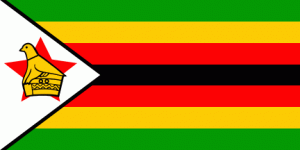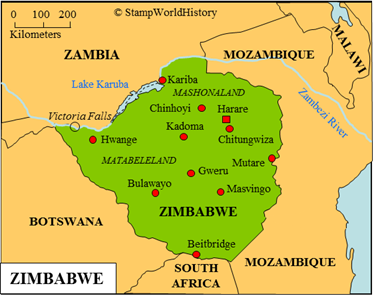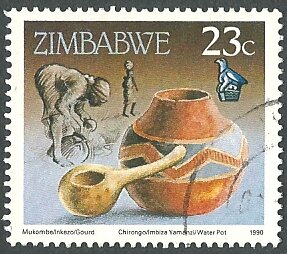
Zimbabwe
Quick reference
General issues: Republic 1980-Present
Country name on general issues: Zimbabwe
Currency: 1 (Zimbabwe) Dollar = 100 Cent 1980-Present
Population: 7 126 000 in 1980, 14 150 000 in 2013
Political history Zimbabwe
Zimbabwe is located in eastern Africa. In the mid 19th century Mashonaland and Matabeleland are the two most important kingdoms in the future Zimbabwe. The British establish a presence, from 1889, through the British South Africa Company – a chartered company. As the British South Africa Company gains control over more and more territory, the administrative divisions are frequently changed. Eventually, two protectorates are formed in 1911: Northern Rhodesia – the current Zambia – and Southern Rhodesia – the current Zimbabwe.
The charter of the British South Africa Company ends in 1924 and thus, in 1923, the administration of Southern Rhodesia is transferred to the British government, Southern Rhodesia becoming a British colony. From 1953 until 1963, Southern Rhodesia is part of the federation of Rhodesia & Nyasaland, which also incorporates Northern Rhodesia and Nyasaland. When the federation is dissolved, Southern Rhodesia, once again, becomes a British colony, now with self government. The name of the country is, upon this occasion, changed from Southern Rhodesia to Rhodesia – without the consent of the British.

One of the natural landmarks of Zimbabwe are the Victoria Falls in the Zambezi River
To continue the privileged position of the white minority, Rhodesia unilaterally declares independence in 1965 – initially with the intention to stay within the British Commonwealth. This declaration of independence in not recognized – not by the British nor by the international community. As the British continue to deny recognition for an independent Rhodesia, Rhodesia, in 1970, declares full independence as the republic of Rhodesia and exits the British Commonwealth.
Meanwhile, the black population has begun to organize itself and has started a guerrilla war – often called the Rhodesian Bush War. The war, and the continuing international pressure, in 1979 lead to concessions of the government. Finally, in late 1979, parties reach an agreement. Colonial rule will be reestablished to prepare general elections that are held in 1980. The name of the country is changed to Zimbabwe-Rhodesia in 1979 and in 1980 to Zimbabwe as we know it until today. The republic of Zimbabwe will gain international recognition.
Zimbabwe, after 1980, will be ruled by the same party with the same leader – Robert Mugabe – elections being flawed. A campaign of land reforms in 2000 – set up to redistribute the land owned by the white minority to the black majority – led to an exodus among the white population and damaged the economy that depends on agriculture and mining. International sanctions still apply to force Mugabe to democratic reforms.
Postal history Zimbabwe
The first stamps used in Zimbabwe are, from 1890, the issues from the British South Africa Company. Next, from 1925 the stamps of Southern Rhodesia are used and, from 1954, the issues of the federation of Rhodesia & Nyasaland. Stamps of Southern Rhodesia will again be used from 1964. Rhodesia will issue its first stamps in 1965 – first as a British colony, later, in 1965, as the independent Rhodesia and, from 1970, as the republic of Rhodesia. From 1980, the stamps of Rhodesia are superseded by those of Zimbabwe.
Album pages
← Previous page: ZanzibarNext page: Zululand →



